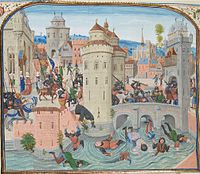Jacquerie

As Grande jacquerie one is uprising of peasants in Kingdom of France in 1358, respectively. The peasant revolts of the 16th and 17th centuries in different regions of southern France are also called jacqueries . The name 'Jacquerie' is derived from the nickname Jacques Bonhomme , which the nobles gave to the farmers. According to other sources, the leader, Caillet , had this nickname, which was subsequently transferred to all farmers.
Grande Jacquerie
France had to contend with the destruction of the Hundred Years War against England and with the effects of numerous plague epidemics . King John II was also abducted by the English after the battle of Maupertuis in 1356.
The cause of the uprising was the devastation that Charles the Evil of Navarre wreaked in the area around Paris and which hit the peasant class particularly hard. In February 1358, the Parisian trades rose up against the nobility under the Prévôt des marchands Étienne Marcel . The successes of this uprising encouraged the peasants to rise up against their tormentors, who oppressed them as hard as possible and, among other things, demanded that the peasants repair their estates devastated by the English free of charge. On May 21, 1358, the uprising began in Compiègne and spread to northeastern France. The rebels laid hundreds of castles in ruins, murdered noblemen and committed numerous atrocities.
Eventually the knights of all parties came to an agreement , and on June 10, 1358 they managed to stifle the movement. They took terrible revenge on the rebels. As a result, the area northeast of Paris remained completely devastated for many decades, and centuries later the nobility, too, lived in fear of a repetition of these events.
Further popular uprisings in France
- Because of the dissatisfaction of the population with the salt tax ( gabelle ) that existed earlier but was institutionalized by Charles V, regionally limited uprisings ( Jacqueries des Pitauds ) occurred in the years 1520–1550, especially in the south of France .
- In the late period of the Huguenot Wars (1562–1598), the peasants rose up in some areas of France and demonstratively sided with the Catholic League ( Jacqueries des Gautiers ).
- In the years 1590–1600, due to the increasing impoverishment of the rural population in parts of northern France, but also in Aquitaine (especially in the Quercy as well as in the Périgord and the Angoumois ), there were also popular surveys called Jacqueries des Croquants . These flared up again in 1624, 1635–1637, 1638–1642, 1643 and 1707.
- Popular uprisings - the latter also called Fronde - are also known from the times of Cardinal Richelieu and Louis XIV .
- Another survey took place in Normandy in 1639 ( Révolte des va-nu-pieds ).
See also
Web links
- The uprising of "Jacques Bonhomme" in 1358
- Jacquerie . In: Meyers Konversations-Lexikon . 4th edition. Volume 9, Verlag des Bibliographisches Institut, Leipzig / Vienna 1885–1892, p. 120.
